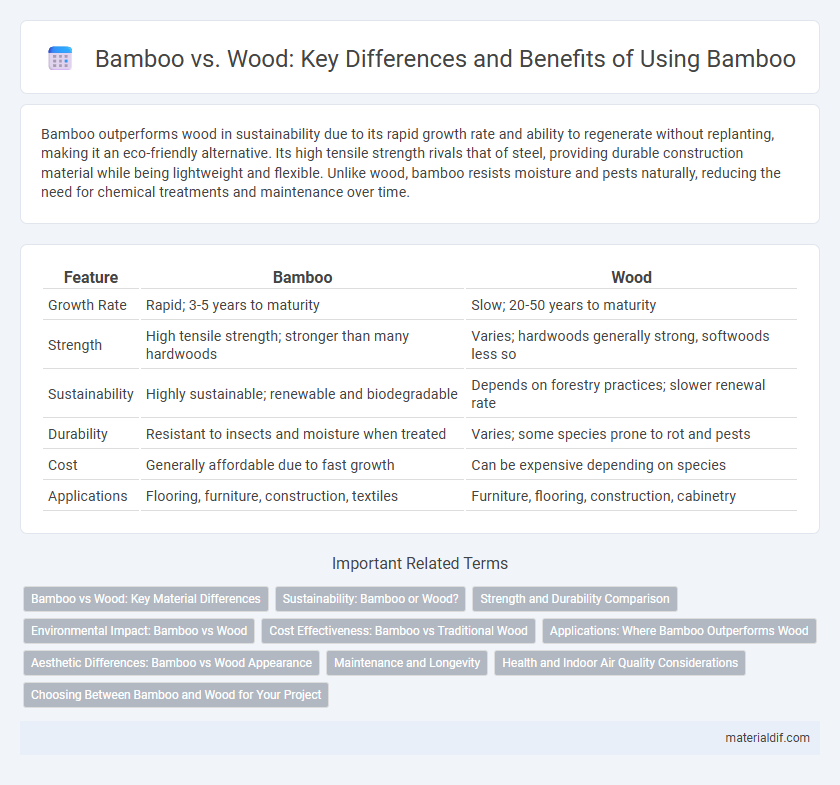Bamboo outperforms wood in sustainability due to its rapid growth rate and ability to regenerate without replanting, making it an eco-friendly alternative. Its high tensile strength rivals that of steel, providing durable construction material while being lightweight and flexible. Unlike wood, bamboo resists moisture and pests naturally, reducing the need for chemical treatments and maintenance over time.
Table of Comparison
| Feature | Bamboo | Wood |
|---|---|---|
| Growth Rate | Rapid; 3-5 years to maturity | Slow; 20-50 years to maturity |
| Strength | High tensile strength; stronger than many hardwoods | Varies; hardwoods generally strong, softwoods less so |
| Sustainability | Highly sustainable; renewable and biodegradable | Depends on forestry practices; slower renewal rate |
| Durability | Resistant to insects and moisture when treated | Varies; some species prone to rot and pests |
| Cost | Generally affordable due to fast growth | Can be expensive depending on species |
| Applications | Flooring, furniture, construction, textiles | Furniture, flooring, construction, cabinetry |
Bamboo vs Wood: Key Material Differences
Bamboo differs from wood in its rapid growth rate, reaching maturity in 3-5 years compared to decades for most hardwoods, making it a highly renewable resource. Structurally, bamboo has a higher tensile strength than steel and a compressive strength comparable to concrete, while wood varies widely depending on species and density. Bamboo's hollow, tubular morphology offers lightweight durability and flexibility, contrasting with wood's solid, fibrous grain which impacts its strength and workability in construction and manufacturing.
Sustainability: Bamboo or Wood?
Bamboo outperforms traditional wood in sustainability due to its rapid growth rate, reaching maturity in just 3-5 years compared to decades for most trees. It requires less water, no pesticides, and helps reduce deforestation by providing a renewable resource with a high carbon sequestration ability. Bamboo's durability and renewability make it an eco-friendly alternative to wood, supporting sustainable construction and manufacturing while preserving forest ecosystems.
Strength and Durability Comparison
Bamboo exhibits superior tensile strength compared to many hardwoods, with a strength-to-weight ratio that often exceeds steel. Its rapid growth cycle and natural resistance to pests and moisture enhance durability, making it an eco-friendly alternative for construction and furniture. While traditional hardwoods may offer localized density, bamboo's fibrous structure provides exceptional flexibility and resilience under stress.
Environmental Impact: Bamboo vs Wood
Bamboo has a significantly lower environmental impact than traditional wood due to its rapid growth rate and ability to regenerate without replanting. Unlike hardwood trees that take decades to mature, bamboo reaches harvest size in 3 to 5 years, reducing deforestation pressure and promoting carbon sequestration. Bamboo cultivation requires fewer pesticides and less water, making it a sustainable alternative to slow-growing wood species in construction and manufacturing.
Cost Effectiveness: Bamboo vs Traditional Wood
Bamboo offers superior cost effectiveness compared to traditional wood due to its rapid growth rate and renewable harvesting cycles, reducing raw material expenses significantly. Its durability and natural resistance to pests and moisture contribute to lower maintenance and replacement costs over time. Consequently, bamboo provides a sustainable and budget-friendly alternative for construction and furniture applications without compromising quality.
Applications: Where Bamboo Outperforms Wood
Bamboo outperforms wood in applications requiring rapid renewability and high strength-to-weight ratio, such as flooring, furniture, and outdoor decking. Its natural resistance to pests and moisture makes it ideal for humid and tropical environments where wood may deteriorate quickly. Bamboo's flexibility and durability also enable innovative construction uses, including scaffolding and eco-friendly building materials.
Aesthetic Differences: Bamboo vs Wood Appearance
Bamboo offers a distinctive aesthetic characterized by its smooth, uniform texture and natural sheen, often featuring a linear, striped pattern that contrasts with the varied grain and knots found in wood. While traditional hardwoods display a range of colors from light to dark with unique grain patterns, bamboo tends to maintain a consistent light golden hue that can be easily stained or treated. The clean, modern look of bamboo makes it popular for contemporary interiors, whereas wood's diverse appearances suit classic and rustic designs.
Maintenance and Longevity
Bamboo offers superior maintenance benefits compared to traditional wood, requiring less frequent sealing and being naturally resistant to pests and moisture. Its rapid growth and dense fiber structure contribute to enhanced longevity, often outlasting many hardwoods under similar environmental conditions. Properly treated bamboo can maintain structural integrity and aesthetic appeal for decades with minimal upkeep.
Health and Indoor Air Quality Considerations
Bamboo emits lower levels of volatile organic compounds (VOCs) compared to traditional wood, enhancing indoor air quality and reducing potential respiratory irritants. Its natural antimicrobial properties inhibit mold and bacteria growth, contributing to healthier indoor environments. Bamboo's rapid renewability and low chemical treatment requirements further minimize exposure to harmful substances commonly associated with wood products.
Choosing Between Bamboo and Wood for Your Project
Bamboo offers a highly sustainable alternative to traditional wood, boasting rapid growth rates and exceptional strength comparable to hardwoods like oak. Its natural resistance to pests and moisture makes bamboo ideal for outdoor or high-humidity projects, reducing the need for chemical treatments often required for wood. When choosing between bamboo and wood, consider project durability, environmental impact, and maintenance requirements to select the most suitable material for your construction or design needs.
Bamboo vs Wood Infographic

 materialdif.com
materialdif.com